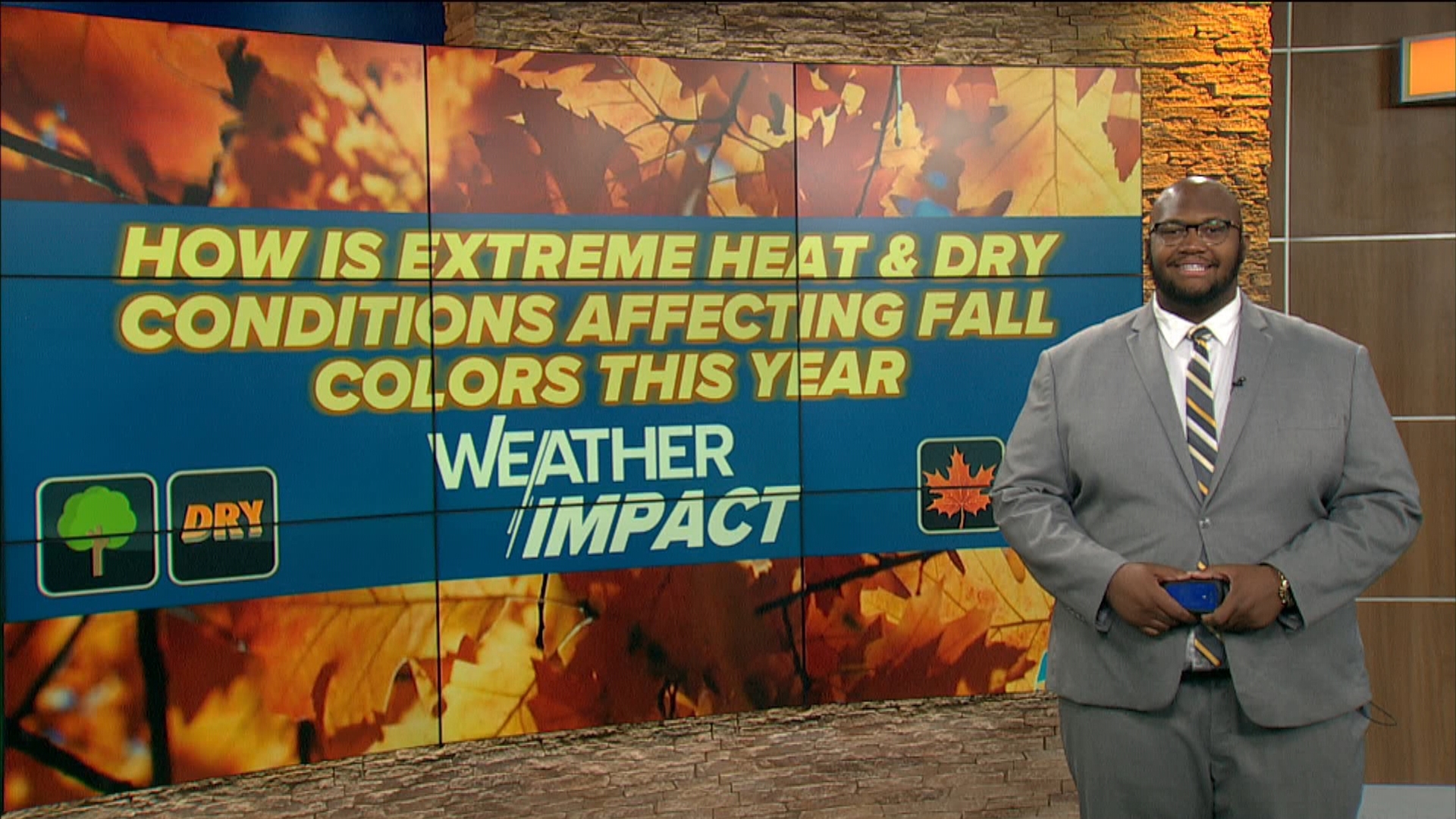TOLEDO, Ohio — As the start of meteorological fall kicks off this week and we go further into the month of September, cooler weather and the taste of pumpkin spice come to mind.
We often say Labor Day marks the unofficial end to summer, but we can still get some summer-like conditions well into September. Like just last week, when we saw yet another week of extremely hot temperatures.
The above-average temperatures lately have just been the start of it.
Last week, we talked about how agriculture is being affected by the heat and we are continuing these problems into this week to talk about how the extreme heat and dry conditions will likely affect fall colors if it continues.
RELATED: How are drought conditions impacting agriculture in northwest Ohio? | WTOL 11 Weather Impact
This week, we are breaking down how this could impact the beautiful fall colors we all love to see as the weather gets cold and nature starts to shine bright and vibrant. Although we still have time to catch up, if current conditions continue, fall foliage will likely look and arrive a bit differently for the 2024 fall season.

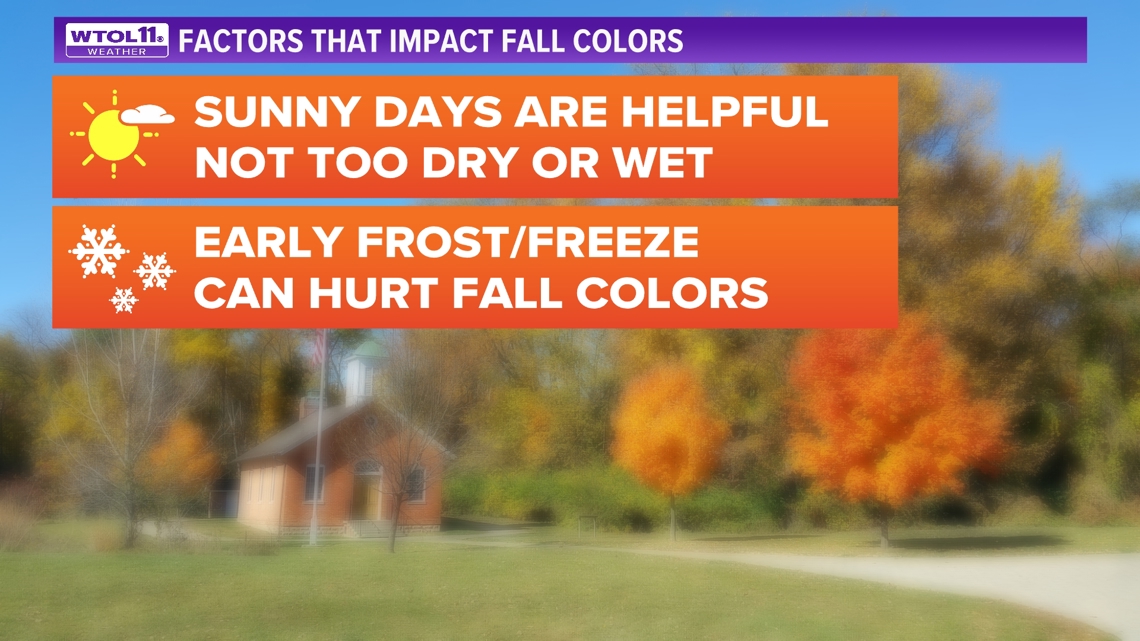
The Perfect Recipe
Just like any other natural phenomenon within the earth, everything is a process that takes each step to succeed. Fall foliage and fall colors must go through that process to successfully happen each year. First, to explain how leaves change color this time of year, it must go through a process in which it gets its vibrant colors.
According to the U.S. Department of Agriculture's Forest Service, "the timing of color changes and the onset of falling leaves is primarily regulated by the calendar as nights become longer. None of the other environmental influences – such as temperature, rainfall, and food supply – are as unvarying as the steadily increasing length of night during autumn. As days grow shorter, and nights grow longer and cooler, biochemical processes in the leaf begin to paint the landscape with nature's autumn palette."
Just a few ingredients to have the perfect fall colors include sunshine, but not too much of it. When the sun is constantly hitting the leaves, it helps peel the pigment from the leaves itself.
Secondly, we need rain showers as well, but too much rain could stunt the changing process within the leaves.
Lastly, the reason fall is the perfect time for leaves to change because it is the first true sign of temperatures getting colder for the first time in about 5 to 6 months. Granted, leaves love the colder weather, but like frost hurting crops, frost and freezing nights can truly hurt fall colors in the worst way.

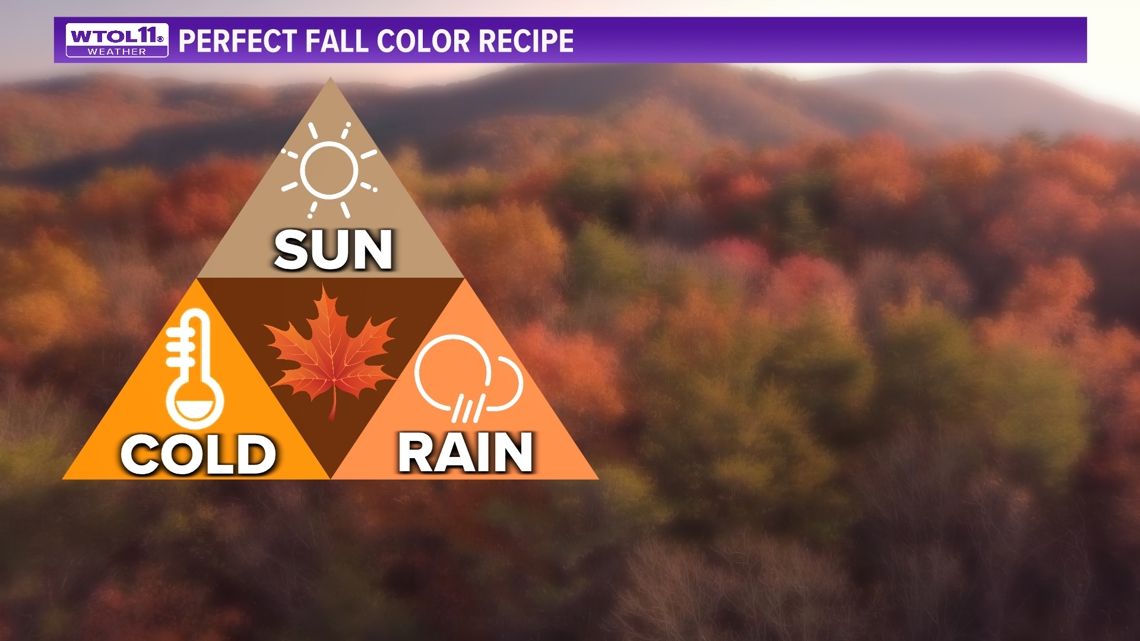
Not too cold and not too hot
Many people enjoy the fall for its great outdoor activities including pumpkin patches and corn mazes, especially because it is not hot anymore and most of the time it is also not as cold as winter will be. It truly is the perfect time to enjoy what fall has to offer.
Fall foliage can be highly impacted if it is too cold early on. From now until early October will truly be the sweet spot for leaves changing colors until we get to peak colors which are typically closer to the end of October.
We talked about frost being detrimental to fall colors, but typically we do not see our average first freeze (which means overnight temperatures drop 28 degrees) until about Oct. 17, with the average first frost not coming until Oct. 6.
So, as it stands right now, frost is not something we have to worry about when it comes to fall colors not being able to produce peak colors. If we do not have frost conditions, then the cooler weather is a perfect ingredient for fall colors to thrive.
One thing we will have to watch is the continued warming trend during fall we have seen over the past several years.
According to Climate Central, Toledo has seen a 4-degree increase in average temperature since 1970. Although that does seem like a lot, the warming trends have become not only more common, but also further into the fall season.
If this continues, the views of fall colors and how long we see them will continue to decrease over the years.

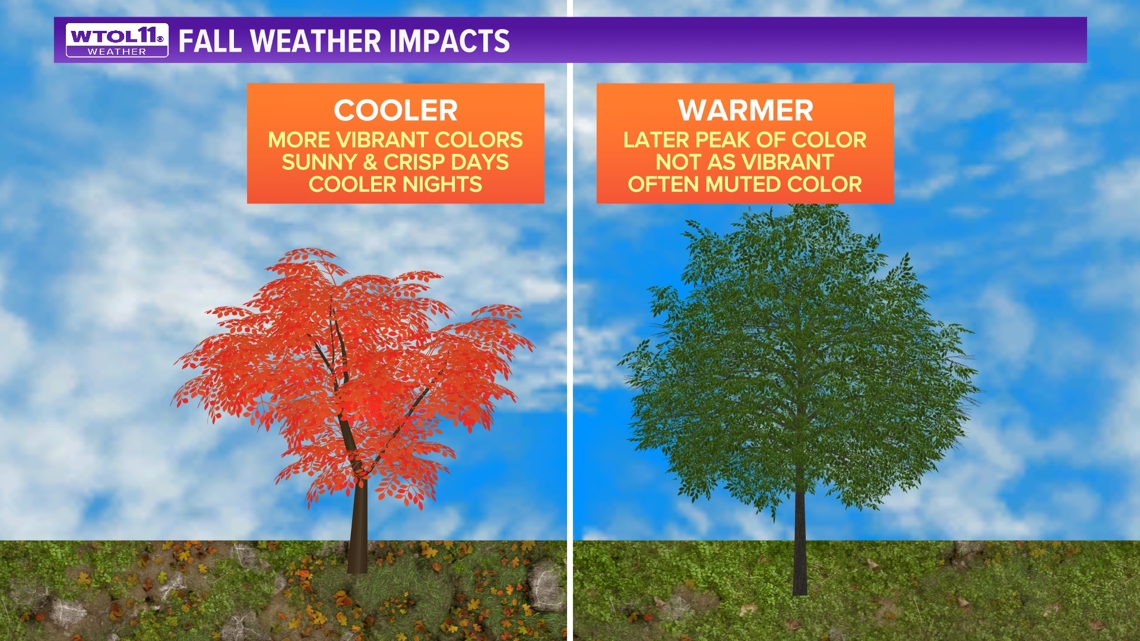
This year’s concern is with dry and warmer conditions
In Ohio, a concerning topic has been about how some leaves prematurely change colors too soon, along with many leaves falling off the trees already. For many, this may be a sign that cooler weather is on the way, but quite frankly it is the opposite. Across the state, several areas are dealing with drought conditions, especially in southeast Ohio.
Currently, southeast Ohio needs a lot of rain and some areas are under an exceptional drought, the highest level on the drought monitor scale. This has been just a catastrophic season for many farmers this year in that area, but that is not the only area where drought conditions are present.
Right here in northwest Ohio, there are several areas where they are currently under a Moderate Drought Level, which is 2 out of 5 on the scale.
Earlier we talked about how too-dry conditions could impact the changing of leaves, due to the lack of moisture these trees need to survive. If we add the extreme heat we have seen lately, then the recipe for fall colors will be heavily impacted this year if these conditions continue into September.
As it stands right now, by the middle of October, we are expected to see not much relief from the dry conditions as below-average precipitation is expected.

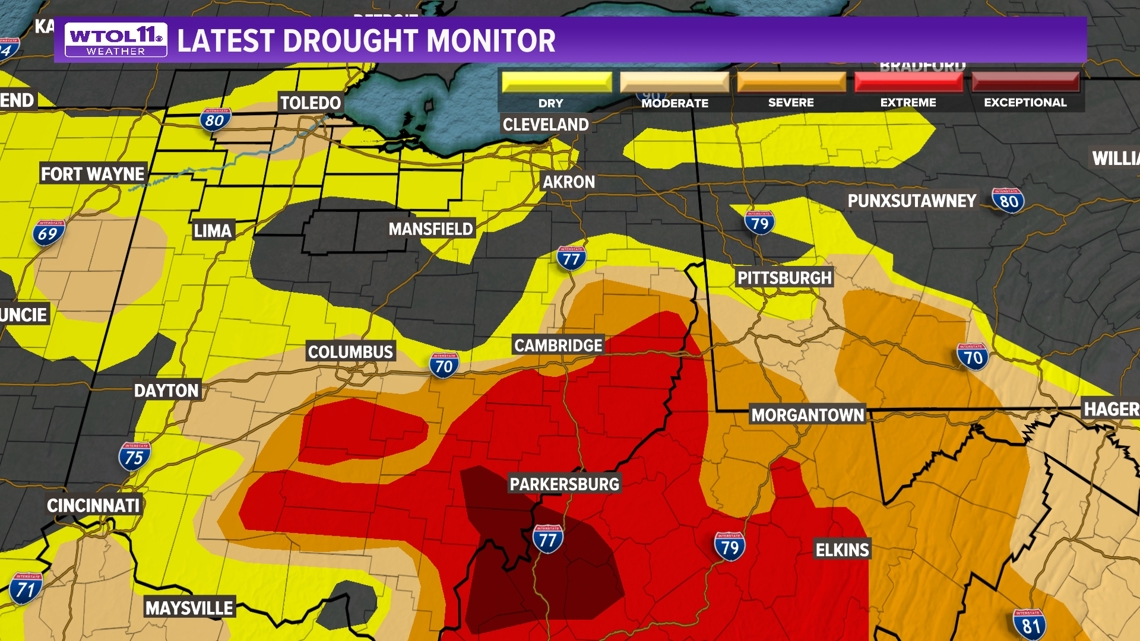
Heat stress impacts
The one-two punches of extreme heat and dry conditions have truly impacted how heat stress is on the trees. So, you are probably wondering: what exactly is heat stress?
According to Science Direct, heat stress is defined as a temperature rise beyond a threshold level for some time sufficient to cause irreversible damage to plant growth and development. Abnormal and prolonged heat stress detrimentally influences tree biology from the cellular to whole-tree scale.
The basic rule of nature growing is water. If we have insufficient water and hotter temperatures, then this stops the trees from growing and completing the proper processes that are done for leaves to in fact change.

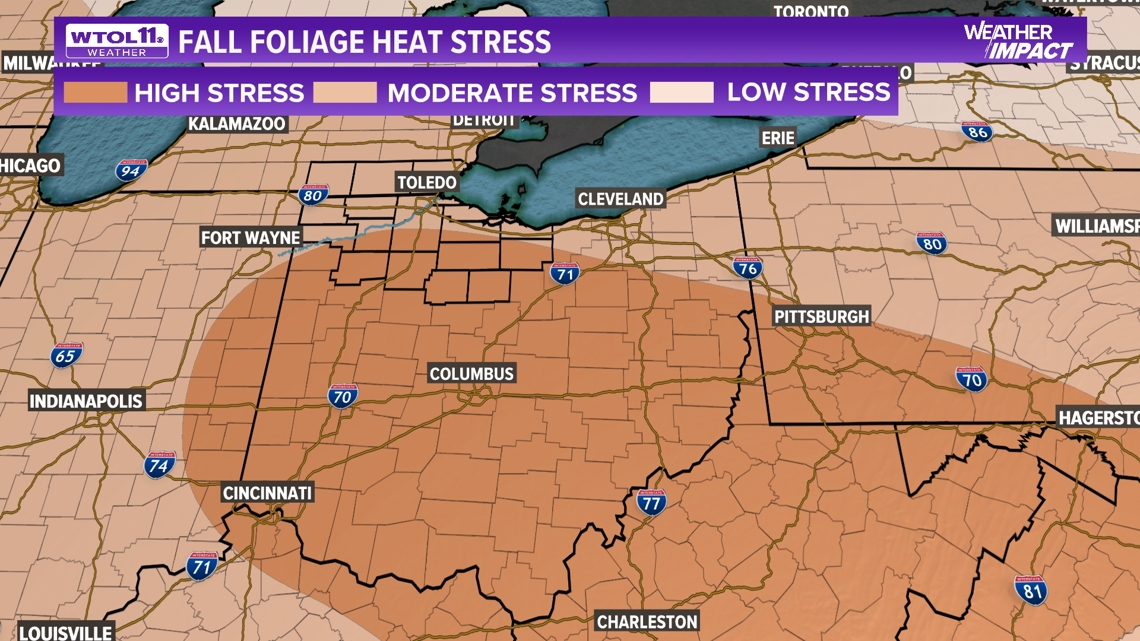
This will continue to lead to premature coloring, which can also result in leaves falling off before peak foliage even arrives. Although this is not expected to continue for an extended period, the chances of a shorter peak fall foliage will become a common theme during the fall months. Sadly, it does stop there with shorter peak seasons, which means we will not see those vibrant colors we are used to seeing every year.
Lastly, fall activities are a billion-dollar industry in which many people travel to see these vast beautiful areas, to see some beautiful fall colors. A lot of parks and towns across the country design areas specifically for fall foliage, but if these conditions become more common over the year when it is dry and hot, we will have to say goodbye to the vibrant colors of fall we all love to see around this time of year.



